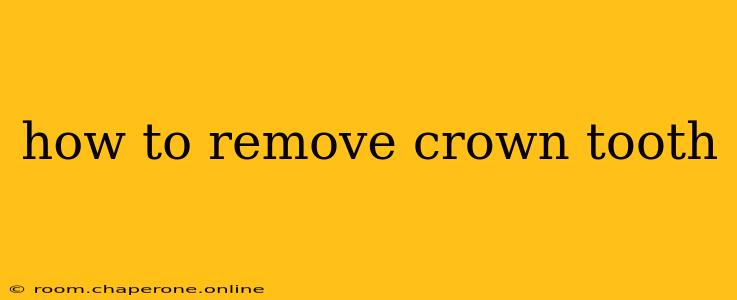Disclaimer: The information provided below is intended for licensed dental professionals only. Attempting to remove a dental crown without proper training and equipment is extremely dangerous and can cause severe damage to the tooth and surrounding tissues. This guide is not for self-treatment or lay individuals. Always consult with a qualified dentist for any dental concerns.
Removing a dental crown requires precision, specialized tools, and a thorough understanding of dental anatomy and procedures. This process is significantly more complex than it might appear and should only be undertaken by trained professionals.
Understanding the Challenges of Crown Removal
Dental crowns are cemented firmly onto the prepared tooth structure. The cement used varies, impacting the removal process. Factors affecting difficulty include:
- Cement Type: Different cements (e.g., resin, zinc phosphate, glass ionomer) have varying strengths and solubilities, requiring different removal techniques.
- Crown Material: The material of the crown (porcelain, metal, ceramic) can influence how it interacts with the removal tools.
- Tooth Structure: The condition of the underlying tooth is crucial. A weakened or decayed tooth will be more vulnerable during crown removal.
- Crown Margin: The fit and location of the crown margin influence accessibility and the risk of damage to the tooth.
Steps Involved in Crown Removal (For Dental Professionals Only)
This section outlines the general steps a dentist would take. Specific techniques may vary depending on the individual case. This is not a DIY guide.
1. Assessment and Preparation:
- Patient Examination: A thorough examination of the crown and the surrounding teeth is essential. Radiographs (X-rays) often help assess the underlying tooth structure and the type of cement used.
- Anesthesia: Local anesthesia is typically administered to ensure patient comfort and minimize discomfort.
- Isolation: The area around the tooth is isolated using a rubber dam to keep it clean and dry.
2. Crown Sectioning (If Necessary):
- Large crowns or those with complex shapes might require sectioning to facilitate removal. This is done using a high-speed handpiece with a specialized bur.
3. Cement Removal:
- Mechanical Removal: Specialized instruments, such as crown removers, excavators, and scaler tips, are used to carefully break the cement bond and loosen the crown. Gentle rocking motions are often employed.
- Chemical Removal: In certain cases, a chemical agent may be used to dissolve or weaken the cement. This approach requires careful control and monitoring to prevent damage to the tooth.
4. Crown Removal:
- Once the cement bond is sufficiently weakened, the crown can be carefully removed using elevators or forceps. Gentle and controlled force is crucial to avoid damaging the tooth.
5. Post-Removal Assessment:
- After removing the crown, the dentist will thoroughly inspect the underlying tooth for any damage, decay, or fractures. Any necessary restorative treatment will be planned and implemented.
Post-Removal Care (Patient Instructions):
This section provides general post-operative instructions that a dentist will give to their patient. This is not a self-treatment guide.
- Pain Management: Over-the-counter pain relievers can help manage any post-operative discomfort.
- Oral Hygiene: Maintain meticulous oral hygiene, including brushing and flossing, to keep the area clean and prevent infection.
- Follow-up Appointments: Attend all scheduled follow-up appointments to monitor healing and ensure the success of any subsequent restorative procedures.
This detailed overview highlights the complexity of crown removal. It is imperative to emphasize again that this procedure should only be performed by a licensed and experienced dental professional. Never attempt to remove a dental crown yourself or with the help of untrained individuals. Contact your dentist for any concerns or issues with your dental crowns.

